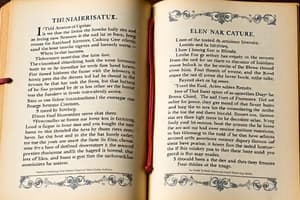Podcast
Questions and Answers
Who wrote The Decameron, a collection of stories?
Who wrote The Decameron, a collection of stories?
- Giovanni Boccaccio (correct)
- Miguel de Cervantes
- William Shakespeare
- Niccolo Machiavelli
Who wrote Don Quixote de la Mancha?
Who wrote Don Quixote de la Mancha?
Miguel de Cervantes
What is the name of the work by Niccolo Machiavelli that is widely considered to be a foundational text of modern political philosophy?
What is the name of the work by Niccolo Machiavelli that is widely considered to be a foundational text of modern political philosophy?
The Prince
Which writer is known for his plays Julius Caesar, Romeo and Juliet, Hamlet, and Anthony and Cleopatra?
Which writer is known for his plays Julius Caesar, Romeo and Juliet, Hamlet, and Anthony and Cleopatra?
Who wrote In Praise of Folly?
Who wrote In Praise of Folly?
Who is known as the “Father of Microbiology” because of his investigations using the microscope?
Who is known as the “Father of Microbiology” because of his investigations using the microscope?
Who invented the thermometer using alcohol and mercury?
Who invented the thermometer using alcohol and mercury?
What is the name of the scale that was developed by Daniel Gabriel Fahrenheit?
What is the name of the scale that was developed by Daniel Gabriel Fahrenheit?
Which of these artists is known for his work The Last Supper?
Which of these artists is known for his work The Last Supper?
Who is known for his paintings of the Sistine Chapel?
Who is known for his paintings of the Sistine Chapel?
Who presented the theory that Earth revolves around the Sun?
Who presented the theory that Earth revolves around the Sun?
Who invented the telescope?
Who invented the telescope?
What is the name of the work by Isotta Nogarola that is considered to be a significant contribution to Renaissance thought?
What is the name of the work by Isotta Nogarola that is considered to be a significant contribution to Renaissance thought?
Flashcards
What is Decameron?
What is Decameron?
A collection of 100 entertaining stories, often reflecting the social and moral values of the time.
Who is William Shakespeare?
Who is William Shakespeare?
A famous playwright, known for his classic tragedies and comedies. Some of his most famous works include Julius Caesar, Romeo and Juliet, Hamlet, Anthony and Cleopatra, and Scarlet.
What is Don Quixote de la Mancha?
What is Don Quixote de la Mancha?
A satirical novel about a knight errant, Don Quixote, whose quest for adventure leads him into humorous and poignant situations.
What is The Prince?
What is The Prince?
Signup and view all the flashcards
What is In Praise of Folly?
What is In Praise of Folly?
Signup and view all the flashcards
Who is Michelangelo Buonarroti?
Who is Michelangelo Buonarroti?
Signup and view all the flashcards
Who is Leonardo da Vinci?
Who is Leonardo da Vinci?
Signup and view all the flashcards
Who is Raphael Santi?
Who is Raphael Santi?
Signup and view all the flashcards
Who is Nicolas Copernicus?
Who is Nicolas Copernicus?
Signup and view all the flashcards
Who is Galileo Galilei?
Who is Galileo Galilei?
Signup and view all the flashcards
Who is Daniel Gabriel Fahrenheit?
Who is Daniel Gabriel Fahrenheit?
Signup and view all the flashcards
Who is Antonie van Leeuwenhoek?
Who is Antonie van Leeuwenhoek?
Signup and view all the flashcards
Who is Andreas Vesalius?
Who is Andreas Vesalius?
Signup and view all the flashcards
Who is Zacharias Janssen?
Who is Zacharias Janssen?
Signup and view all the flashcards
Who is William Harvey?
Who is William Harvey?
Signup and view all the flashcards
Who is Anders Celsius?
Who is Anders Celsius?
Signup and view all the flashcards
How did geography contribute to the Renaissance in Italy?
How did geography contribute to the Renaissance in Italy?
Signup and view all the flashcards
What role did classical learning play in the Renaissance in Italy?
What role did classical learning play in the Renaissance in Italy?
Signup and view all the flashcards
What was the significance of humanism in the Renaissance?
What was the significance of humanism in the Renaissance?
Signup and view all the flashcards
Who is Francesco Petrarch?
Who is Francesco Petrarch?
Signup and view all the flashcards
Who is Laura Cereta?
Who is Laura Cereta?
Signup and view all the flashcards
Who are Veronica Franco and Vittoria Colonna?
Who are Veronica Franco and Vittoria Colonna?
Signup and view all the flashcards
Who are Sofonisba Anguissola and Artemisia Gentileschi?
Who are Sofonisba Anguissola and Artemisia Gentileschi?
Signup and view all the flashcards
What is Humanism?
What is Humanism?
Signup and view all the flashcards
What is the implication of the efforts of the female humanists during the Renaissance?
What is the implication of the efforts of the female humanists during the Renaissance?
Signup and view all the flashcards
Study Notes
Renaissance Figures
-
Giovanni Boccaccio: Known for "Decameron", a collection of stories, notable for its prose and influential on later literature.
-
Miguel de Cervantes: A celebrated novelist, best known for the novel "Don Quixote," a satirical work about an idealistic knight.
-
Niccolò Machiavelli: Author of "The Prince," a treatise on acquiring and maintaining political power.
-
William Shakespeare: Widely considered the greatest writer in the English language, famous for plays like Hamlet, Romeo and Juliet, and Macbeth.
-
Desiderius Erasmus: A prominent humanist and scholar, known for his educational reforms and his ideas on Christian humanism, notably his work "The Praise of Folly."
Studying That Suits You
Use AI to generate personalized quizzes and flashcards to suit your learning preferences.




